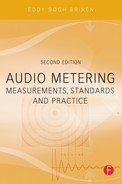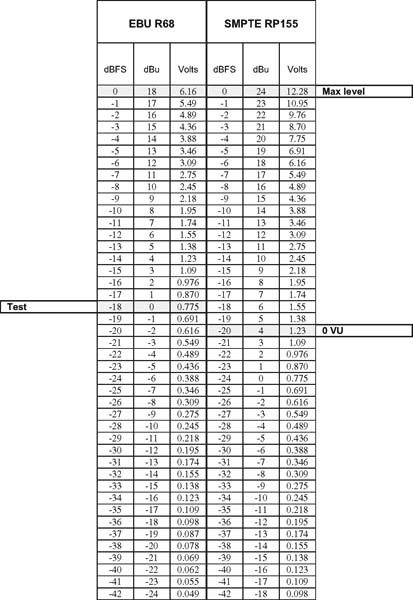Chapter | sexteen
Relationships Between Scales
CHAPTER OUTLINE
When it comes to level meters, the abundance and different types of appearances of the scales are overwhelming. However, most of them share a common trait in that their scales use divisions that are based on units in dB. Yet the portion of the dynamic range the scales cover can be different. For certain purposes, it is important to be able to monitor the entire dynamic range. In other cases, it is only important to see what is occurring in the immediate vicinity of full modulation. Some scales combine both properties.
As far as professional equipment is concerned, good and readable scales predominate. With consumer equipment, it is often the case that the aim is to just have something that moves, and here it is rare that there is any real possibility of performing a calibration.
COMMENTS ON THE SCALES
A number of the scales currently used are shown in Figure 16.1 together with their relationship. Some comments follow in connection with how the scales are shown.
Volts
The scale in volts is included for the sake of comparison. This of course is the RMS value.
FIGURE 16.1 Relation between common scales)) see the section. SVI or VU.
dBu
The unit dBu is an absolute magnitude with the reference 0.775 V. Most of the scales express the voltage of the signal.
IEC I, Nordic Scale
This scale is the most important among professionals and broadcasters in the Nordic countries.
IEC I, BBC
With respect to the standard, there are 4 dB between each subdivision. However, there are some instruments with 6 dB between the lowest steps on the scale.
IEC IIb
This scale is used for the adjustment of transmission lines.
DIN

FIGURE 16.2 Scale subdivisions as originally described in “Pflichtenheft Nr. 3/6, Inst. für Rundfunktechnik” (Requirements for Broadcasting).
SVI or VU
This scale is used with little adherence to any standard. It has to be mentioned that the scale originally did not have VU as a unit. The VU on the scale only indicates that this instrument is a Standard Volume Indicator. The reading of the instrument is found on the attenuator in front of the meter.
That said, we must acknowledge the different ways this instrument and its scale is used – mostly without applying the attenuator.
There are three different scale offsets shown in Figure 16.1:
Direct reading: When 1.23 V is applied, the reading on the scale is 0 if either no attenuator is used in front of the meter – or the attenuator in front of the meter is set in a position where it does not attenuate. However, the volume is actually +4 (dBm) according to the standard.
In North America and Australia, this is actually the correct reading if no attenuation is applied. In France, the scale is further displaced so that 0 on the scale corresponds to 0.616 V.
M/S Scales
Some meters provide an M/S scale, displaying the direct relation of the in-phase contents compared to the anti-phase contents of the left and right channel.
Loudness Scales
The loudness scales cannot be compared unless the algorithms forming the reading are exactly identical.
EBU vs. SMPTE
The last scale shows the relation to EBU R68, which gives the correlation between the analog signal level and its digital coding. Yet another standard exists: SMPTE RP155. Unfortunately, they are not identical. The relationship between the two is shown in Figure 16.1. It shows that 0 dBFS corresponds to +18 dBu according to the EBU standard. Similarly, 0 dBFS is equal to +24 dBu according to SMPTE. Hence, you must know the conversion factor in order to ensure that inexplicable jumps in level of up to 6 dB do not occur. This will happen in particular if you have a mixture of American and European sources.
Figure 16.3 Relationship between the analog signal level and digital coding in converters as per the EBU and SMPTE standards, respectively.


